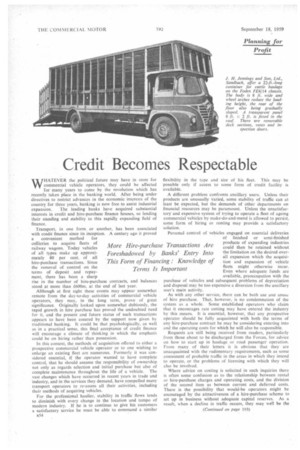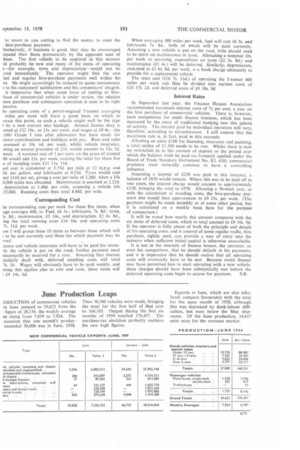Credit Becomes Respectable
Page 88

Page 93

If you've noticed an error in this article please click here to report it so we can fix it.
WHATEVER the political future may have in store for commercial vehicle operators, they could be affected for many years to come by the revolution which has recently taken place in the banking world. After being under directives to restrict advances in the economic interests of the country for three years, banking is now free to assist industrial
expansion. The leading banks have acquired substantial interests in credit and hire-purchase finance houses, so lending their standing and stability to this rapidly expanding field of finance.
Transport, in one form or another, has been associated with credit finance since its inception. A century ago it proved a convenient method for collieries to acquire fleets of railway wagons. Today vehicles of all types make up approximately 80 per cent. of all hire-purchase transactions. Since the removal of control on the terms of deposit and repayment, there has been a sharp rise in the number of hire-purchase contracts, and balances stood at more than £600m, at the end of last year.
Although at first sight these events may appear somewhat remote from the day-to-day activities of commercial vehicle operators, they may, in the long term, prove of great significance. Originally looked upon somewhat dubiously, the rapid growth in hire purchase has proved the undoubted need for it, and the present and future status of such transactions appears to have been assured by the support now given by traditional banking, it could be that psychologically, as well as in a practical sense, this final acceptance of credit finance will encourage a climate of thinking in which the emphasis could be on hiring rather than possession.
In this context, the methods of acquisition offered to either a prospective commercial vehicle operator or to one wishing to enlarge an existing fleet are numerous. Formerly it was considered essential, if the operator wanted to have complete control, that he should assume the responsibility of ownership not only as regards selection and initial purchase but also of complete maintenance throughout the life of a vehicle. The vast changes which have occurred in recent years in trade and industry, and in the services they demand, have compelled many transport operators to re-assess all their activities, including their methods of acquiring vehicles.
For the professional haulier, stability in traffic flows tends to diminish with every change in the location and tempo of modern industry. If he is to continue to give his customers a satisfactory service he must be able to command a similar flexibility in the type and size of his fleet. This may be possible only if access to some form of credit facility is available.
A different problem confronts ancillary users. Unless their products are unusually varied, some stability of traffic can at least be expected, but the demands of other departments on financial resources may be paramount. Unless the unsatisfactory and expensive system of trying to operate a fleet of ageing commercial vehicles by make-do-and-mend is allowed to persist, some form of hiring or renting may provide a satisfactory solution.
Personal control of vehicles engaged on essential deliveries of finished or semi-finished products of expanding industries could then be retained without the limitation on the desired overall expansion which the acquisition and expansion of vehicle fleets might otherwise incur. Even where adequate funds are available, preoccupation with the purchase of vehicles and subsequent problems of depreciation and disposal may be too expensive a diversion from the ancillary user's main activity.
As with any other service, there can be both use and anus,: of hire purchase. That, however, is no condemnation of the system as a whole. Some established operators who claim that it encourages rate cutting may have entered the industry by this means. It is essential, however, that any prospective operator should be fully acquainted with both the terms of any hire-purchase contract he may be considering entering into and the operating costs for which he will also be responsible.
Requests are stilt being received from readers, particularly from those about to be discharged from the Forces, for advice on how to start up in haulage or road passenger operation. From many of their letters it is obvious that they are unacquainted with the rudimentary requirements, such as some assessment of probable traffic in the areas in which they intend to operate, or the problems of licensing with which they will also be involved.
Where advice on costing is solicited in such inquiries there is often some confusion as to the relationship between rental or hire-purchase charges and operating costs, and the division of the second item as between current and deferred costs. There is the possibility that would-be operators might be encouraged by the attractiveness of a hire-purchase scheme to set up in business without adequate capital reserves. As a result, when a decline in traffic occurs, they may well be the to resort to rate cutting to find the money to meet the hire-purchase payment.
lternatively, if business is good, they may be encouraged :xpand their fleets prematurely by the apparent ease of ;base. The first vehicle to be acquired in this manner Id probably be new and many of the items of operating s-for example, tyres and depreciation-would not be rred immediately. The operator might find the cost 'uel and regular hire-purchase payments well within his us. He might accordingly be induced to quote uneconomic s to his customers' satisfaction and his competitors' chagrin. is imperative that when some form of renting or hire:hase of commercial vehicles is under review, the relation ieen purchase and subsequent operation is seen in its right pective.
he operating costs of a petrol-engined 5-tonner averaging miles per week will form a good basis on which to orate this point, as such a vehicle might well be the type I by a new entrant into haulage. Annual licence duty is oned at 132 10s., or 13s. per week, and wages at £9 4s.-the .(661 Grade I rate after allowance has been made for ranee contributions and holidays with pay. Rent and rates assessed at 10s, 6d. per week, whilst vehicle insurance, ming an annual premium of £31. would amount to 12s. 5d. week. A nominal rate of 3 per cent. on the price of around 00 would add 12s. per week, making the total for these five is of standing costs £11 its. lid.
eel cost is calculated at 3.75d. per mile at 12 m.p.g. and d. per gallon, and lubricants at 0.23d. Tyres would cost ind -1160 per set, giving a cost per mile of 1.28d. when a life 0,000 miles was obtained. Maintenance is assessed at 2.22d. depreciation at 1.40d. per mile, assuming a vehicle life 25,000. Running costs then total 8.88d. per mile.
Corresponding Cost he corresponding cost per week for these five items, when age averages 400, is: Fuel, £6 5s.; lubricants, 7s. 8d.; tyres, s. 8d.; maintenance. £3 14s., and depreciation. £2 6s. 8d., ing the total running costs £14 16s. and operating costs 7s. lid, per week.
ow I will group these 10 items as between those which will to be met currently and those for which payment may be rred.
cence and vehicle insurance will have to be paid for immeAy the vehicle is put on the road, further payment need necessarily be incurred for a year. Assuming that interest imilarly dealt with, deferred standing costs will total 7s. 5d. Wages will obviously have to be paid weekly, and ming this applies also to rent and rates. these items will £9 14s. 6d. When averaging 400 miles per week, fuel will cost £6 5s. and lubricants 7s. 8d., both of which will be paid currently. Assuming a new vehicle is put on the road, little should need to be spent on maintenance or tyres. Allocating a nominal 10s. per week to servicing, expenditure on tyres (£2 2s. 8d.) and maintenance (13 4s.) will be deferred. Similarly, depreciation, reckoned at £2 6s. 8d. per week, is a book charge ultimately to provide for a replacement vehicle.
The total cost (£26 7s. 11d.) of operating the 5-tonner .400 miles per week can thus be divided into current costs of £16 17s. 2d. and deferred costs of £9 10s. 9d.
interest Rates
In September last year, the Finance Houses Association recommended maximum interest rates of 7i per cent. a year on the hire purchase of commercial vehicles. There is, however, keen competition for credit finance business, which has been increased by the entry of traditional banking into this sphere of activity. The interest paid by individual operators will vary, therefore, according to circumstances, I will assume that the maximum rate is, in fact, paid in this example. Allowing an extra £100 for licensing, insurance and painting, a total outlay of £1,100 needs to be met. Whilst there is now no restriction as to the amount of deposit or the period over which the balance must be paid (as formerly applied under the Board of Trade Statutory Instrument No. S.I. 430), commercial prudence must naturally continue to have a controlling influence.
Assuming a deposit of £250 was paid in this instance, a balance of £850 would remain. Where this was to be paid off in two years, the interest charge would amount to approximately £128, bringing the total to £978. Allowing a 50-week year, as with the calculation of standing costs, the hire-purchase payment due would then approximate to £9 15s, per week. (The payment might be made monthly or at some other period, but it is calculated on a weekly basis here for the purpose of comparison.) It will be noted how nearly this amount compares with the six items of deferred costs, which in total amount to £9 10s. 9d. If the operator is fully aware of both the principle and details of his operating costs, and is assured of some regular traffic, hire purchase, rightly used, can provide a way of entry into the industry when sufficient initial capital is otherwise unavailable.
It is not in the interests of finance houses, the operator, or even his competitors, that he should default in his payments, and it is imperative that he should realize that all operating costs will eventually have to be met. Because credit finance may have permitted him to start operating with a new vehicle, these charges should have been substantially met before the deferred operating costs begin to accrue for payment. S.B.




































































































































